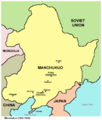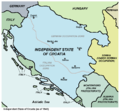Axis powers



Axis countries and Axis Powers are the names for some countries that fought together against the Allies during World War II. The war ended in 1945 with the Axis powers losing and their alliances broken.
Berlin-Rome-Tokyo Axis Powers[change | change source]
The most important Axis countries formed an alliance called the Berlin-Rome-Tokyo Axis Powers (1922 to 1945). They included:
 Nazi Germany under Adolf Hitler
Nazi Germany under Adolf Hitler Kingdom of Italy under Benito Mussolini
Kingdom of Italy under Benito Mussolini Empire of Japan under Hirohito
Empire of Japan under Hirohito

-
Nazi Germany
-
Fascist Italy
-
Imperial Japan
All three countries had authoritarian governments, which were (and still are) often referred to as fascist.
Other countries[change | change source]
Subsequent signatories of the Tripartite Pact[change | change source]
In addition to the main three countries, the less important Axis countries were:
 Kingdom of Hungary under Miklós Horthy
Kingdom of Hungary under Miklós Horthy Kingdom of Romania under Ion Antonescu
Kingdom of Romania under Ion Antonescu Kingdom of Bulgaria under Tsar Boris III
Kingdom of Bulgaria under Tsar Boris III
-
Hungary
-
Romania
Other countries that helped the Axis without being a part of them were:
Co-belligerent states[change | change source]
Client states[change | change source]
 Slovakia
Slovakia Philippines (Second Republic)
Philippines (Second Republic) Vietnam (Empire of Vietnam)
Vietnam (Empire of Vietnam) Manchukuo (Manchuria and eastern Inner Mongolia)
Manchukuo (Manchuria and eastern Inner Mongolia) Reorganized National Government of China
Reorganized National Government of China Independent State of Croatia
Independent State of Croatia Province of Ljubljana
Province of Ljubljana Italian Social Republic
Italian Social Republic
Controversial cases[change | change source]
- Denmark signed treaty of mutual non-aggression.
- Spain was neutral, but gave non-military assistance.
- Vichy France agreed not to resist after Northern France was conquered. Allowed (forced?) to allow Japan to occupy French Indochina.
-
Manchukuo
-
Slovakia
-
Vichy France
-
Croatia
-
Italian Social Republic
Several new or rebel governments that were created by the Axis during the war are:










